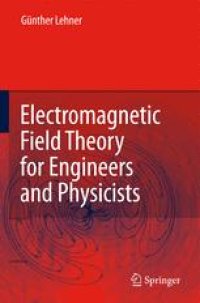
Ebook: Electromagnetic Field Theory for Engineers and Physicists
Author: Günther Lehner (auth.)
- Tags: Microwaves RF and Optical Engineering, Optics and Electrodynamics, Engineering general, Electrical Engineering
- Year: 2008
- Publisher: Springer-Verlag Berlin Heidelberg
- Edition: 1
- Language: English
- pdf
This established, didactically excellent textbook unifies intuitiveness with extraordinary precision of its terminology and the derivation of concepts. It was developed as manuscript to teach students in electrical engineering, and has served to do so for thousands of students over two decades.
Discussed is the electromagnetic field theory and its mathematical methods. Maxwell’s equations are presented and explained. It follows a detailed discussion of electrostatics, flux problems, magnetostatics, quasi stationary fields, and electromagnetic waves.
The author presents how to apply numerical methods like finite differences, finite elements, boundary elements, image charge methods, and Monte-Carlo methods to field theory problems. He offers an outlook on fundamental issues in physics including quantum mechanics. Some of these issues concern still unanswered questions. A chapter dedicated to the theory of special relativity, which allows to simplify a number of field theory problems, complements this book.
This book’s usefulness is not limited to engineering students, but can also be very helpful for physicists and other branches of science.
This established, didactically excellent textbook unifies intuitiveness with extraordinary precision of its terminology and the derivation of concepts. It was developed as manuscript to teach students in electrical engineering, and has served to do so for thousands of students over two decades.
Discussed is the electromagnetic field theory and its mathematical methods. Maxwell’s equations are presented and explained. It follows a detailed discussion of electrostatics, flux problems, magnetostatics, quasi stationary fields, and electromagnetic waves.
The author presents how to apply numerical methods like finite differences, finite elements, boundary elements, image charge methods, and Monte-Carlo methods to field theory problems. He offers an outlook on fundamental issues in physics including quantum mechanics. Some of these issues concern still unanswered questions. A chapter dedicated to the theory of special relativity, which allows to simplify a number of field theory problems, complements this book.
This book’s usefulness is not limited to engineering students, but can also be very helpful for physicists and other branches of science.
This established, didactically excellent textbook unifies intuitiveness with extraordinary precision of its terminology and the derivation of concepts. It was developed as manuscript to teach students in electrical engineering, and has served to do so for thousands of students over two decades.
Discussed is the electromagnetic field theory and its mathematical methods. Maxwell’s equations are presented and explained. It follows a detailed discussion of electrostatics, flux problems, magnetostatics, quasi stationary fields, and electromagnetic waves.
The author presents how to apply numerical methods like finite differences, finite elements, boundary elements, image charge methods, and Monte-Carlo methods to field theory problems. He offers an outlook on fundamental issues in physics including quantum mechanics. Some of these issues concern still unanswered questions. A chapter dedicated to the theory of special relativity, which allows to simplify a number of field theory problems, complements this book.
This book’s usefulness is not limited to engineering students, but can also be very helpful for physicists and other branches of science.
Content:
Front Matter....Pages i-xxvi
Maxwell’s Equations....Pages 1-39
Basics of Electrostatics....Pages 40-116
Formal Methods of Electrostatics....Pages 117-231
The Stationary Current Density Field....Pages 232-255
Basics of Magnetostatics....Pages 256-342
Time Dependent Problems I (Quasi Stationary Approximation)....Pages 343-404
Time Dependent Problems II (Electromagnetic Waves)....Pages 405-505
Numerical Methods....Pages 506-568
Back Matter....Pages 569-659
This established, didactically excellent textbook unifies intuitiveness with extraordinary precision of its terminology and the derivation of concepts. It was developed as manuscript to teach students in electrical engineering, and has served to do so for thousands of students over two decades.
Discussed is the electromagnetic field theory and its mathematical methods. Maxwell’s equations are presented and explained. It follows a detailed discussion of electrostatics, flux problems, magnetostatics, quasi stationary fields, and electromagnetic waves.
The author presents how to apply numerical methods like finite differences, finite elements, boundary elements, image charge methods, and Monte-Carlo methods to field theory problems. He offers an outlook on fundamental issues in physics including quantum mechanics. Some of these issues concern still unanswered questions. A chapter dedicated to the theory of special relativity, which allows to simplify a number of field theory problems, complements this book.
This book’s usefulness is not limited to engineering students, but can also be very helpful for physicists and other branches of science.
Content:
Front Matter....Pages i-xxvi
Maxwell’s Equations....Pages 1-39
Basics of Electrostatics....Pages 40-116
Formal Methods of Electrostatics....Pages 117-231
The Stationary Current Density Field....Pages 232-255
Basics of Magnetostatics....Pages 256-342
Time Dependent Problems I (Quasi Stationary Approximation)....Pages 343-404
Time Dependent Problems II (Electromagnetic Waves)....Pages 405-505
Numerical Methods....Pages 506-568
Back Matter....Pages 569-659
....